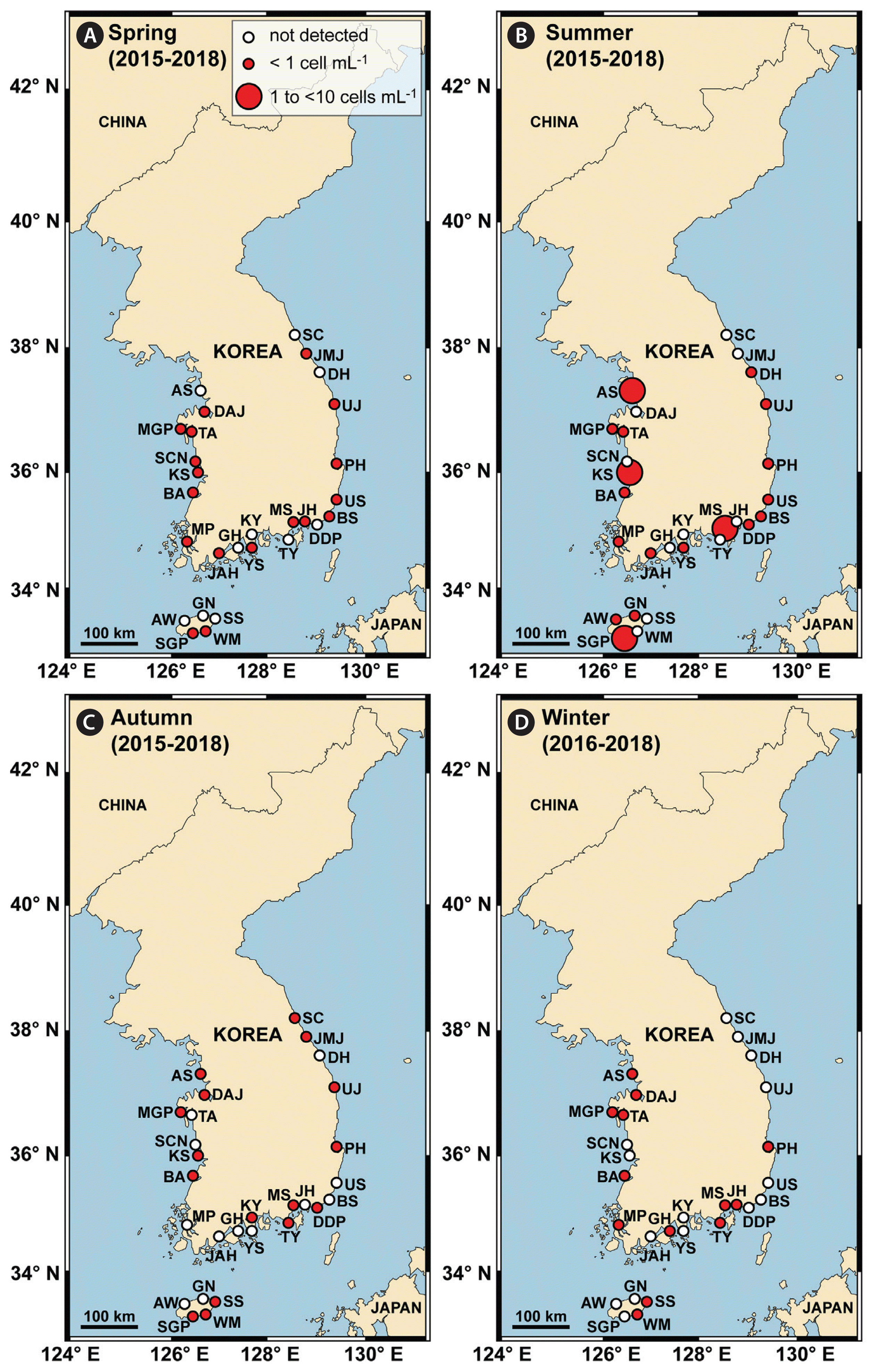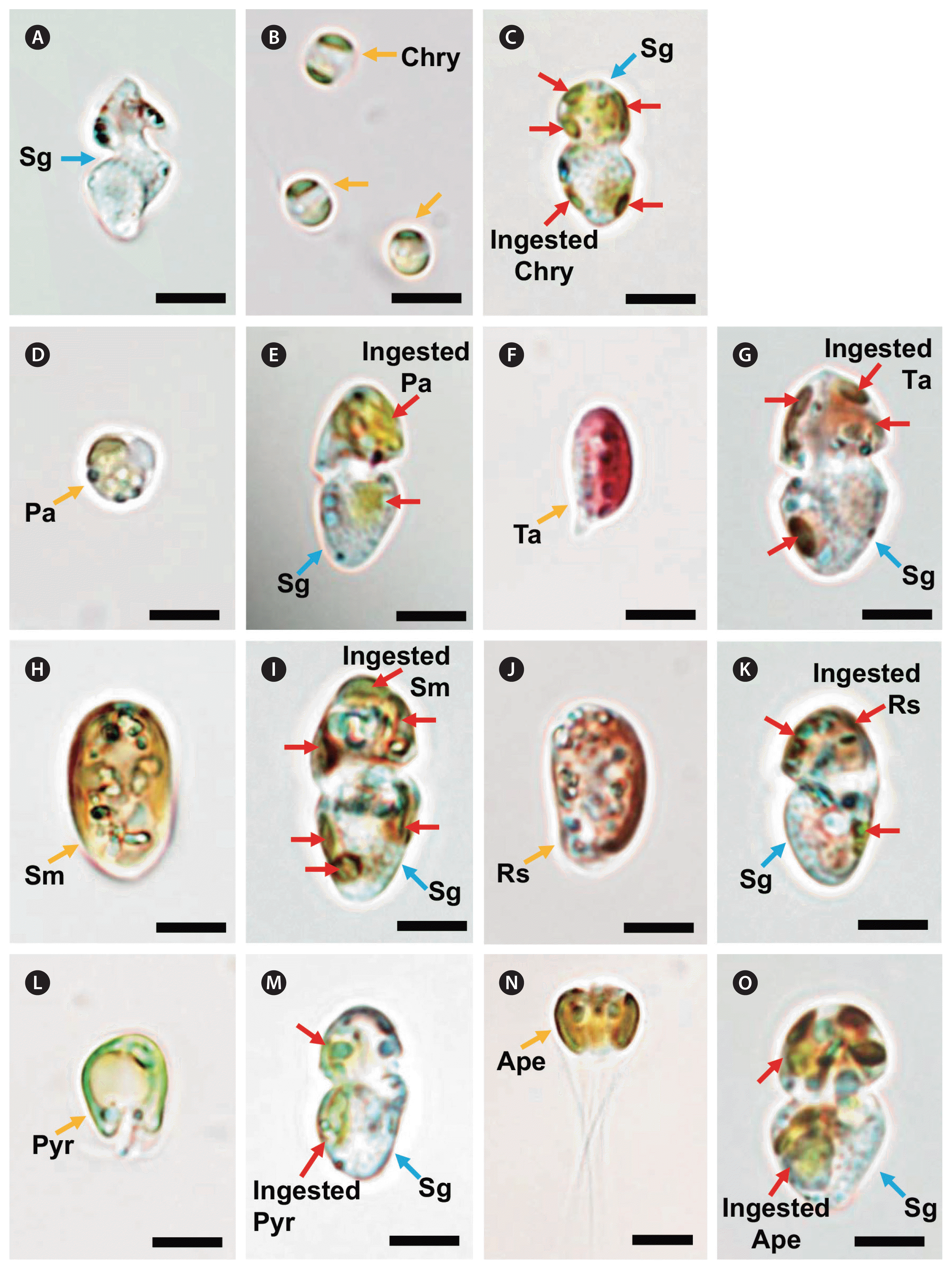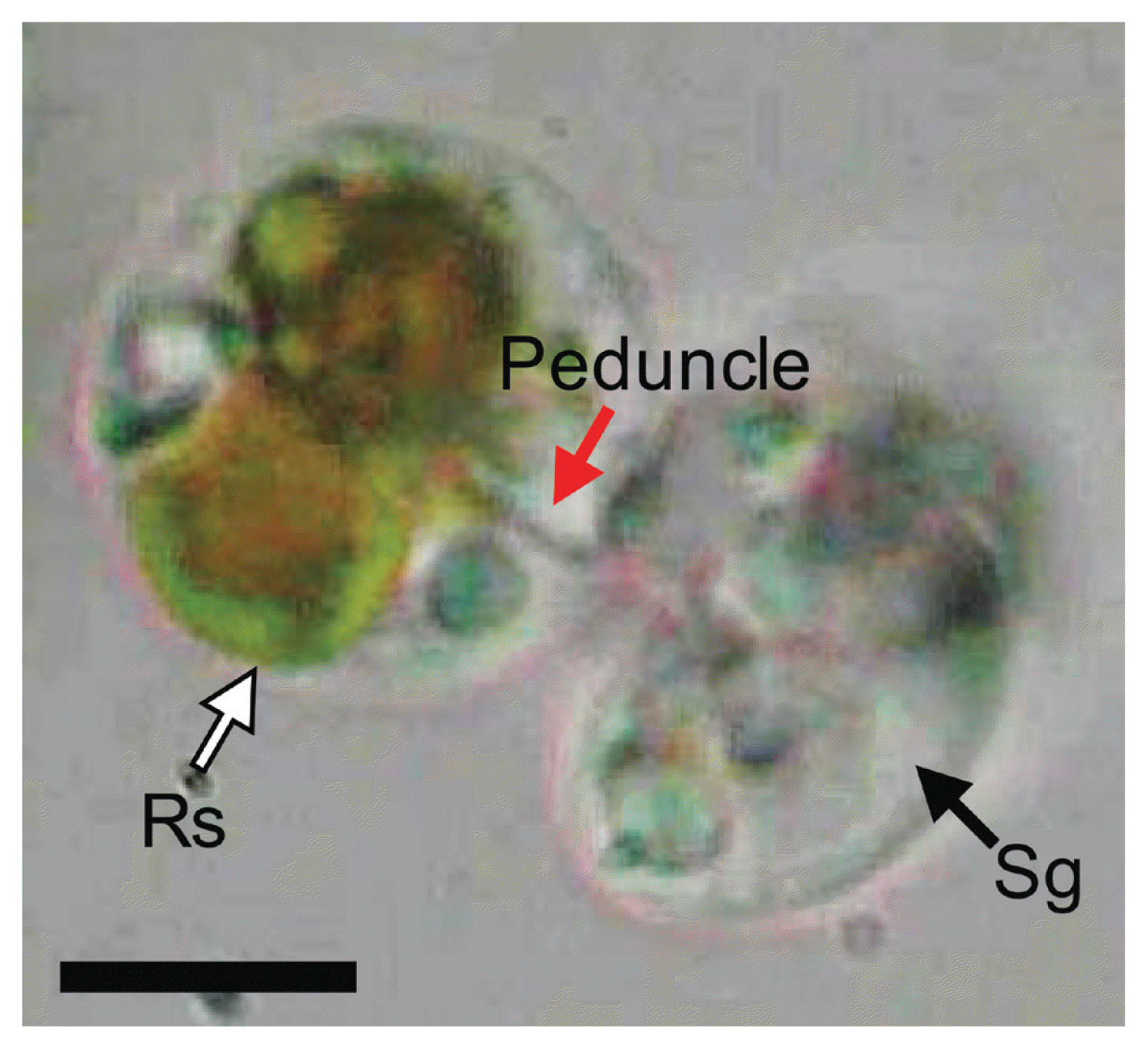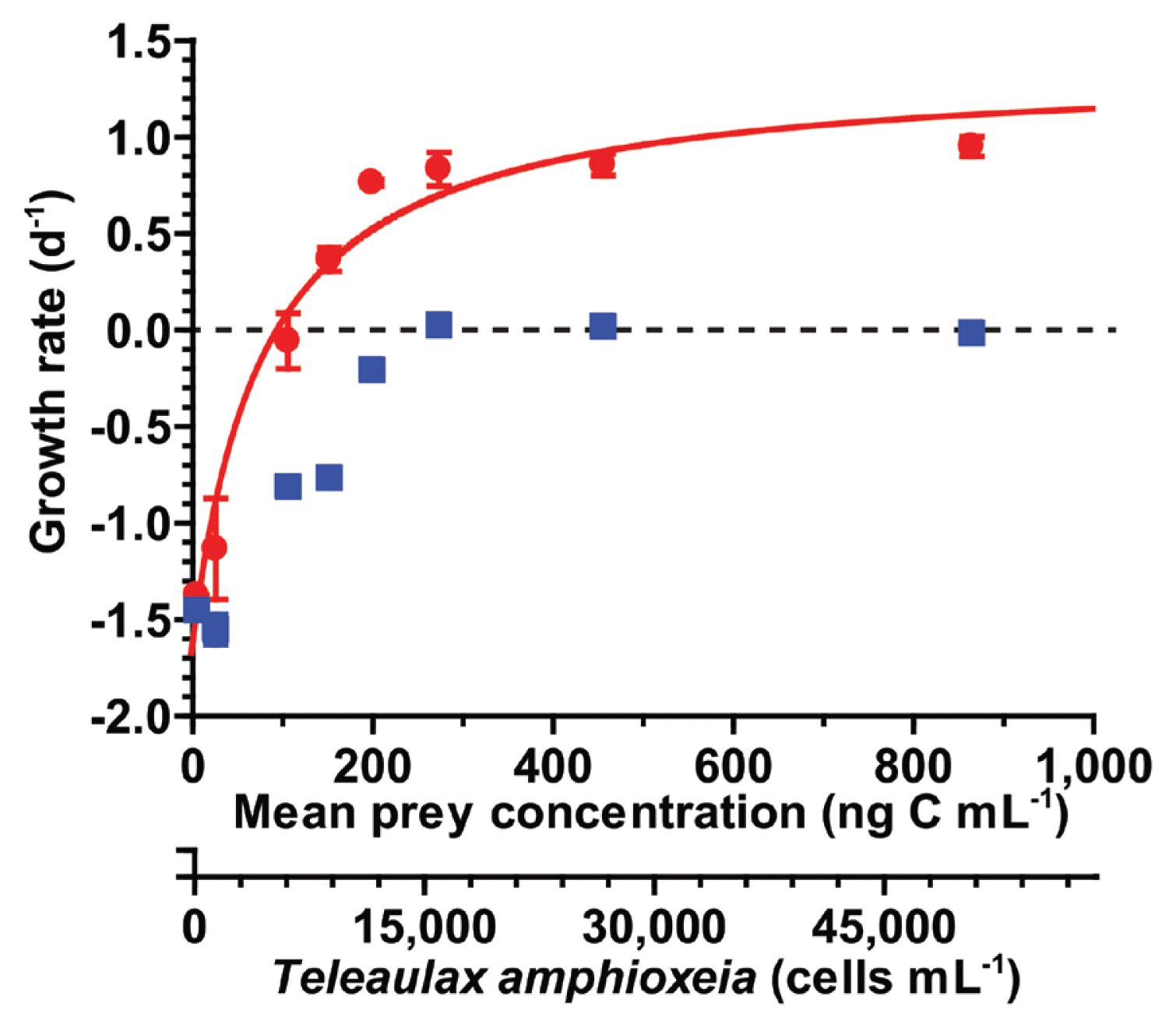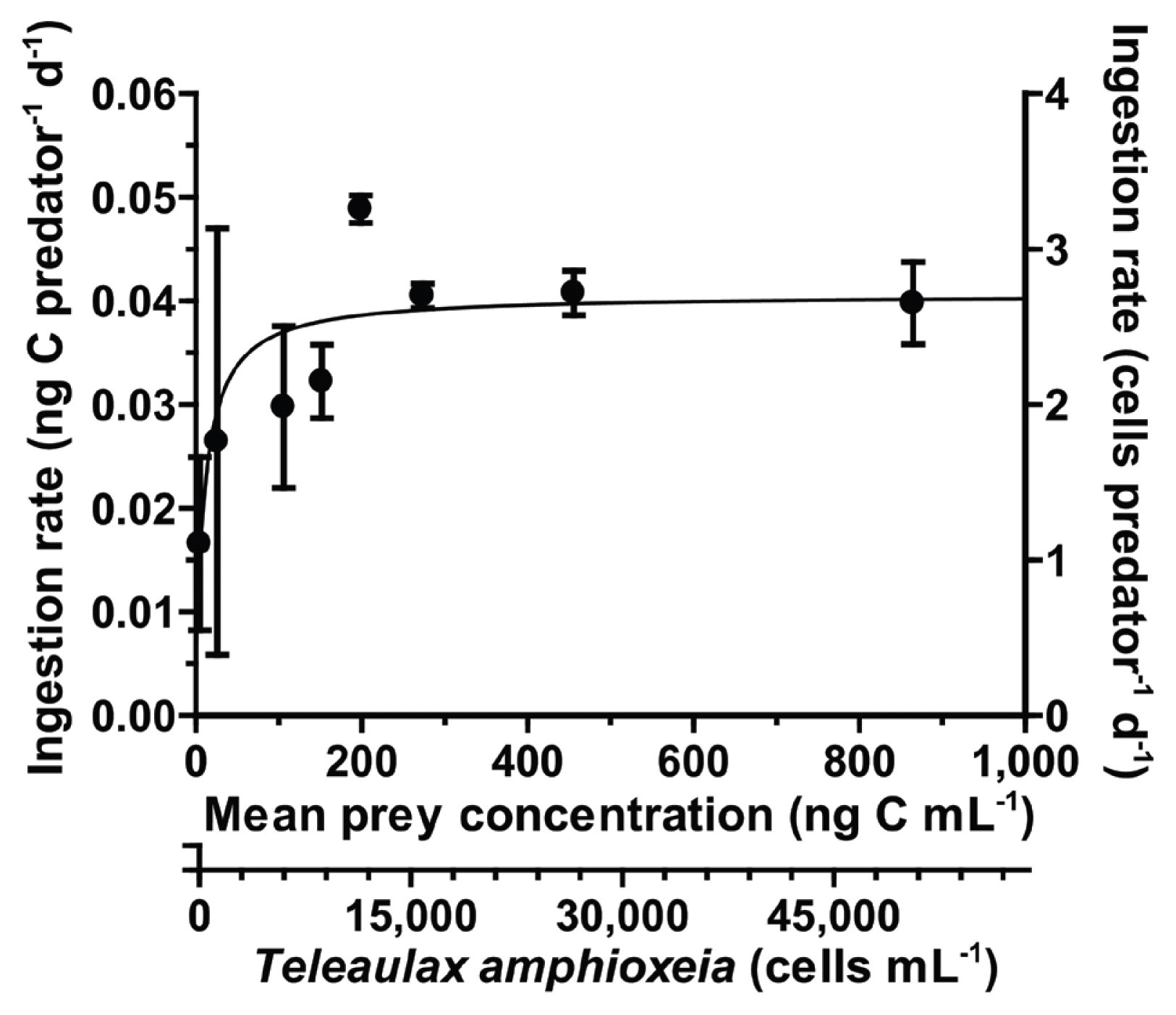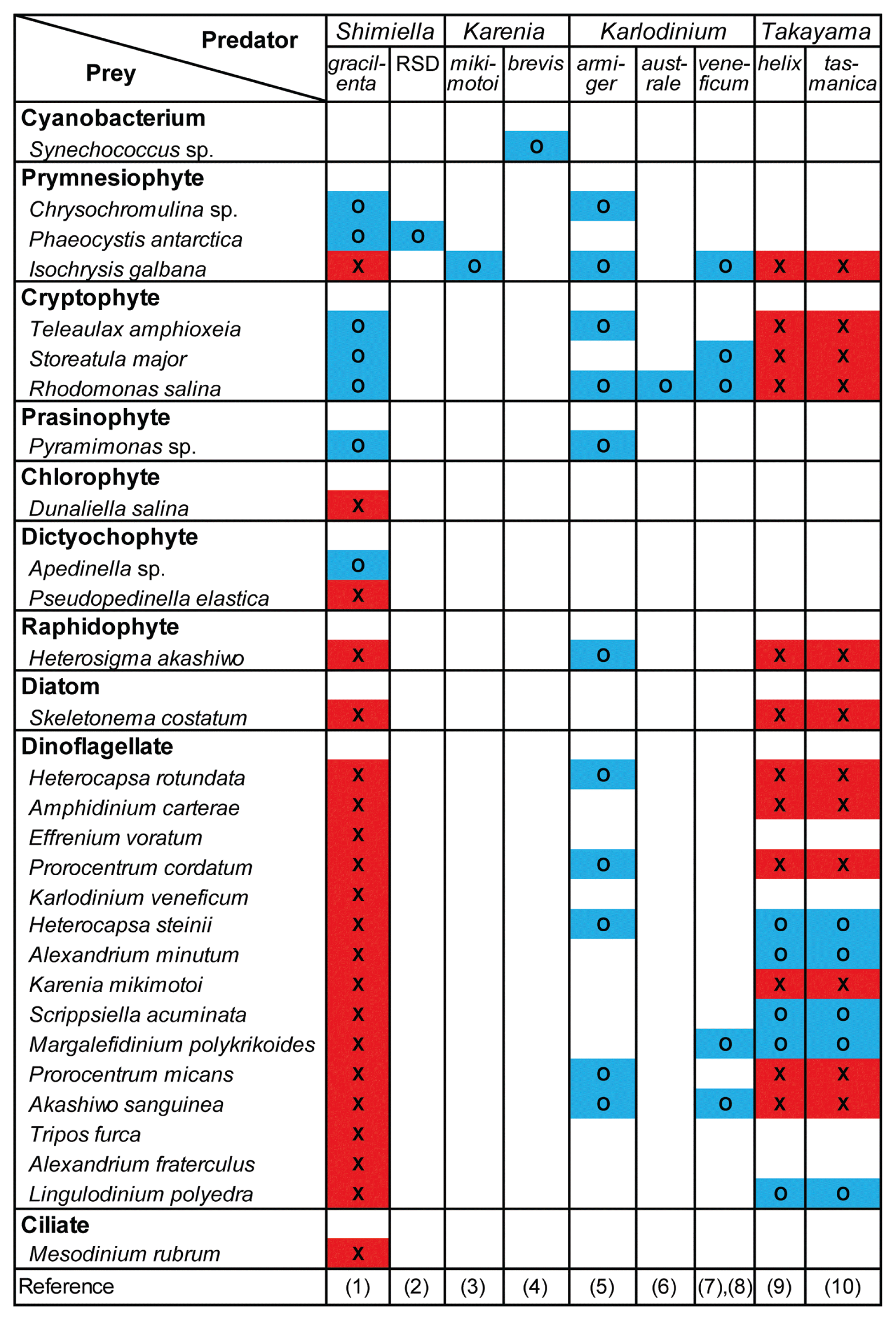Al-Mutairi, M, Subrahmanyam, MNV, Ali, M, Isath, S, AlAwadi, MA, Kumar, PN, Al-Hebini, K & Omar, SAS 2020. Temporal variations in abundance and species richness of phytoplankton with emphasis on diatoms in the subtidal waters of Umm Al-Namil Island, north-western Arabian Gulf of the ROPME Sea Area. J Environ Biol. 41:1470–1485.

Back, D, Ha, S, Else, B, Hanson, M, Jones, SF, Shin, K, Tatarek, A, Wiktor, JM, Cicek, N, Alam, S & Mundy, CJ 2021. On the impact of wastewater effluent on phytoplankton in the Arctic coastal zone: a case study in the Kitikmeot Sea of the Canadian Arctic. Sci Total Environ. 764:143861.

Baek, SH, Shimode, S, Han, M-S & Kikuchi, T 2008a. Growth of dinoflagellates,
Ceratium furca and
Ceratium fusus in Sagami Bay, Japan: the role of nutrients. Harmful Algae. 7:729–739.

Baek, SH, Shimode, S & Kikuchi, T 2008b. Growth of dinoflagellates,
Ceratium furca and
Ceratium fusus in Sagami Bay, Japan: the role of temperature, light intensity and photoperiod. Harmful Algae. 7:163–173.

Berge, T, Hansen, PJ & Moestrup, Ø 2008. Feeding mechanism, prey specificity and growth in light and dark of the plastidic dinoflagellate
Karlodinium armiger
. Aquat Microb Ecol. 50:279–288.

Bockstahler, KR & Coats, DW 1993. Spatial and temporal aspects of mixotrophy in Chesapeake Bay dinoflagellates. J Eukaryot Microbiol. 40:49–60.

Booth, BC & Smith, WO Jr 1997. Autotrophic flagellates and diatoms in the Northeast Water Polynya, Greenland: summer 1993. J Mar Syst. 10:241–261.

Burkholder, JM, Glasgow, HB & Deamer-Mella, N 2001. Overview and present status of the toxic
Pfiesteria complex (Dinophyceae). Phycologia. 40:186–214.

Campbell, PH 1973. The phytoplankton of Gales Creek with emphasis on the taxonomy and ecology of estuarine phytoflagellates. PhD dissertation. University of North Carolina, Chapel Hill, NC, USA, 354 pp.
Cloern, JE, Alpine, AE, Cole, BE, Wong, RLJ, Arthur, JF & Ball, MD 1983. River discharge controls phytoplankton dynamics in the northern San Francisco Bay estuary. Estuar Coast Shelf Sci. 16:415–429.

Coats, DW 1999. Parasitic life styles of marine dinoflagellates. J Eukaryot Microbiol. 46:402–409.

Cohu, S, Thibaut, T, Mangialajo, L, Labat, J, Passafiume, O, Blanfuné, A, Simon, N, Cottalorda, J & Lemée, R 2011. Occurrence of the toxic dinoflagellate
Ostreopsis cf.
ovata in relation with environmental factors in Monaco (NW Mediterranean). Mar Pollut Bull. 62:2681–2691.

Díaz, P, Molinet, C, Cáceres, MA & Valle-Levinson, A 2011. Seasonal and intratidal distribution of
Dinophysis spp. in a Chilean fjord. Harmful Algae. 10:155–164.

Drira, Z, Hamza, A, Belhassen, M, Ayadi, H, Bouaïn, A & Aleya, L 2008. Dynamics of dinoflagellates and environmental factors during the summer in the Gulf of Gabes (Tunisia, Eastern Mediterranean Sea). Sci Mar. 72:59–71.
de Salas, MF, Bolch, CJS & Hallegraeff, GM 2005.
Karlodinium australe sp. nov. (Gymnodiniales, Dinophyceae), a new potentially ichthyotoxic unarmoured dinoflagellate from lagoonal habitats of south-eastern Australia. Phycologia. 44:640–650.

de Sousa, MIL 2020. Biogeography of Arctic Eukaryotic Microbiome: A comparative approach between 18S rRNA gene metabarcoding and microscopic analysis. MS dissertation. University of Porto, Porto, Portugal, 94 pp.
Eom, SH, Jeong, HJ, Ok, JH, Park, SA, Kang, HC, You, JH, Lee, SY, Yoo, YD, Lim, AS & Lee, MJ 2021. Interactions between common heterotrophic protists and the dinoflagellate
Tripos furca: implication on the long duration of its red tides in the South Sea of Korea in 2020. Algae. 36:25–36.

Fraga, S, Rodríguez, F, Bravo, I, Zapata, M & Marañón, E 2012. Review of the main ecological features affecting benthic dinoflagellate blooms. Cryptogam Algol. 33:171–179.

Frost, BW 1972. Effects of size and concentration of food particles on the feeding behavior of the marine planktonic copepod
Calanus pacificus
. Limnol Oceanogr. 17:805–815.

Gast, RJ, Moran, DM, Beaudoin, DJ, Blythe, JN, Dennett, MR & Caron, DA 2006. Abundance of a novel dinoflagellate phylotype in the Ross Sea, Antarctica. J Phycol. 42:233–242.

Gast, RJ, Moran, DM, Dennett, MR & Caron, DA 2007. Kleptoplasty in an Antarctic dinoflagellate: caught in evolutionary transition? Environ Microbiol. 9:39–45.

Gímez, MI, Piola, AR, Kattner, G & Alder, VA 2011. Biomass of autotrophic dinoflagellates under weak vertical stratification and contrasting chlorophyll levels in subantarctic shelf waters. J Plankton Res. 33:1304–1310.

Glibert, PM, Burkholder, JM, Kana, TM, Alexander, J, Skelton, H & Shilling, C 2009. Grazing by
Karenia brevis on
Synechococcus enhances its growth rate and may help to sustain blooms. Aquat Microb Ecol. 55:17–30.

Golubkov, M, Nikulina, V & Golubkov, S 2019. Effects of environmental variables on midsummer dinoflagellate community in the Neva Estuary (Baltic Sea). Oceanologia. 61:197–207.

Guillard, RRL & Hargraves, PE 1993.
Stichochrysis immobilis is a diatom, not a chrysophyte. Phycologia. 32:234–236.

Guillard, RRL & Ryther, JH 1962. Studies of marine planktonic diatoms: I.
Cyclotella nana Hustedt, and
Detonula confervacea (Cleve) Gran. Can J Microbiol. 8:229–239.

Hallegraeff, GM 1993. A review of harmful algal blooms and their apparent global increase. Phycologia. 32:79–99.

Hansen, PJ 1991a. Dinophysis: a planktonic dinoflagellate genus which can act both as a prey and a predator of a ciliate. Mar Ecol Prog Ser. 69:201–204.

Hansen, PJ 1991b. Quantitative importance and trophic role of heterotrophic dinoflagellates in a coastal pelagial food web. Mar Ecol Prog Ser. 73:253–261.

Hattenrath-Lehmann, T & Gobler, CJ 2015. The contribution of inorganic and organic nutrients to the growth of a North American isolate of the mixotrophic dinoflagellate,
Dinophysis acuminata
. Limnol Oceanogr. 60:1588–1603.

Hehenberger, E, Gast, RJ & Keeling, PJ 2019. A kleptoplastidic dinoflagellate and the tipping point between transient and fully integrated plastid endosymbiosis. Proc Natl Acad Sci. 116:17934–17942.

Heinbokel, JF 1978. Studies on the functional role of tintinnids in the Southern California Bight. I. Grazing and growth rates in laboratory cultures. Mar Biol. 47:177–189.

Hernández-Becerril, DU, Lau, WLS, Hii, KS, Leaw, CP, Varona-Cordero, F & Lim, PT 2018. Abundance and distribution of the potentially toxic thecate dinoflagellate Alexandrium tamiyavanichii (Dinophyceae) in the Central Mexican Pacific, using the quantitative PCR method. Front Mar Sci. 5:366 pp.
Jakobsen, HH, Hansen, PJ & Larsen, J 2000. Growth and grazing responses of two chloroplast-retaining dinoflagellates: effect of irradiance and prey species. Mar Ecol Prog Ser. 201:121–128.

Jang, SH & Jeong, HJ 2020. Spatio-temporal distributions of the newly described mixotrophic dinoflagellate
Yihiella yeosuensis (Suessiaceae) in Korean coastal waters and its grazing impact on prey populations. Algae. 35:45–59.

Jang, SH, Jeong, HJ, Kwon, JE & Lee, KH 2017. Mixotrophy in the newly described dinoflagellate
Yihiella yeosuensis: a small, fast dinoflagellate predator that grows mixotrophically, but not autotrophically. Harmful Algae. 62:94–103.

Jeong, HJ 1999. The ecological roles of heterotrophic dinoflagellates in marine planktonic community. J Eukaryot Microbiol. 46:390–396.

Jeong, HJ, Ha, JH, Park, JY, Kim, JH, Kang, NS, Kim, S, Kim, JS, Yoo, YD & Yih, WH 2006. Distribution of the heterotrophic dinoflagellate
Pfiesteria piscicida in Korean waters and its consumption of mixotrophic dinoflagellates, raphidophytes and fish blood cells. Aquat Microb Ecol. 44:263–278.

Jeong, HJ, Ha, JH, Yoo, YD, Park, JY, Kim, JH, Kang, NS, Kim, TH, Kim, HS & Yih, WH 2007. Feeding by the
Pfiesteria-like heterotrophic dinoflagellate
Luciella masanensis
. J Eukaryot Microbiol. 54:231–241.

Jeong, HJ, Kang, HC, Lim, AS, Jang, SH, Lee, K, Lee, SY, Ok, JH, You, JH, Kim, JH, Lee, KH, Park, SA, Eom, SH, Yoo, YD & Kim, KY 2021a. Feeding diverse prey as an excellent strategy of mixotrophic dinoflagellates for global dominance. Sci Adv. 7:eabe4214.

Jeong, HJ, Lee, KH, Yoo, YD, Kang, NS & Lee, K 2011. Feeding by the newly described, nematocyst-bearing heterotrophic dinoflagellate
Gyrodiniellum shiwhaense
. J Eukaryot Microbiol. 58:511–524.

Jeong, HJ, Lim, AS, Franks, PJS, Lee, KH, Kim, JH, Kang, NS, Lee, MJ, Jang, SH, Lee, SY, Yoon, EY, Park, JY, Yoo, YD, Seong, KA, Kwon, JE & Jang, TY 2015. A hierarchy of conceptual models of red-tide generation: nutrition, behavior, and biological interactions. Harmful Algae. 47:97–115.

Jeong, HJ, Lim, AS, Yoo, YD, Lee, MJ, Lee, KH, Jang, TY & Lee, K 2014. Feeding by heterotrophic dinoflagellates and ciliates on the free-living dinoflagellate
Symbiodinium sp. (Clade E). J Eukaryot Microbiol. 61:27–41.

Jeong, HJ, Ok, JH, Lim, AS, Kwon, JE, Kim, SJ & Lee, SY 2016. Mixotrophy in the phototrophic dinoflagellate
Takayama helix (family Kareniaceae): predator of diverse toxic and harmful dinoflagellates. Harmful Algae. 60:92–106.

Jeong, HJ, Yoo, YD, Kang, NS, Rho, JR, Seong, KA, Park, JW, Nam, GS & Yih, W 2010a. Ecology of Gymnodinium aureolum. I. Feeding in western Korean waters. Aquat Microb Ecol. 59:239–255.
Jeong, HJ, Yoo, YD, Kim, JS, Kim, TH, Kim, JH, Kang, NS & Yih, W 2004. Mixotrophy in the phototrophic harmful alga
Cochlodinium polykrikoides (Dinophycean): prey species, the effects of prey concentration, and grazing impact. J Eukaryot Microbiol. 51:563–569.

Jeong, HJ, Yoo, YD, Kim, JS, Seong, KA, Kang, NS & Kim, TH 2010b. Growth, feeding and ecological roles of the mixotrophic and heterotrophic dinoflagellates in marine planktonic food webs. Ocean Sci J. 45:65–91.

Jeong, HJ, Yoo, YD, Lee, K, Kang, HC, Kim, JS & Kim, KY 2021b. Annual carbon retention of a marine-plankton community in the eutrophic Masan Bay, based on daily measurements. Mar Biol. 168:69 pp.

Jeong, HJ, Yoo, YD, Lee, KH, Kim, TH, Seong, KA, Kang, NS, Lee, SY, Kim, JS, Kim, S & Yih, WH 2013. Red tides in Masan Bay, Korea in 2004–2005: I. Daily variations in the abundance of red-tide organisms and environmental factors. Harmful Algae. 30(Suppl 1):S75–S88.

Jeong, HJ, Yoo, YD, Park, JY, Song, JY, Kim, ST, Lee, SH, Kim, KW & Yih, WH 2005a. Feeding by phototrophic red-tide dinoflagellates: five species newly revealed and six species previously known to be mixotrophic. Aquat Microb Ecol. 40:133–150.

Jeong, HJ, Yoo, YD, Seong, KA, Kim, JH, Park, JY, Kim, SH, Lee, SH, Ha, JH & Yih, WH 2005b. Feeding by the mixotrophic dinoflagellate
Gonyaulax polygramma: mechanisms, prey species, effects of prey concentration, and grazing impact. Aquat Microb Ecol. 38:249–257.

Johnson, MD 2011. The acquisition of phototrophy: adaptive strategies of hosting endosymbionts and organelles. Photosynth Res. 107:117–132.

Johnson, MD, Stoecker, DK & Marshall, HG 2013. Seasonal dynamics of Mesodinium rubrum in Chesapeake Bay. J Plankton Res. 35:877–893.
Kang, HC, Jeong, HJ, Lim, AS, Ok, JH, You, JH, Park, SA, Lee, SY & Eom, SH 2020. Effects of temperature on the growth and ingestion rates of the newly described mixotrophic dinoflagellate
Yihiella yeosuensis and its two optimal prey species. Algae. 35:263–275.

Kang, HC, Jeong, HJ, Ok, JH, You, JH, Jang, SH, Lee, SY, Lee, KH, Park, JY & Rho, J-R 2019. Spatial and seasonal distributions of the phototrophic dinoflagellate
Biecheleriopsis adriatica (Suessiaceae) in Korea: quantification using qPCR. Algae. 34:111–126.

Kang, NS, Jeong, HJ, Yoo, YD, Yoon, EY, Lee, KH, Lee, K & Kim, G 2011. Mixotrophy in the newly described phototrophic dinoflagellate
Woloszynskia cincta from western Korean waters: feeding mechanism, prey species and effect of prey concentration. J Eukaryot Microbiol. 58:152–170.

Kibbe, WA 2007. OligoCalc: an online oligonucleotide properties calculator. Nucleic Acids Res. 35:W43–W46.

Kim, JS, Jeong, HJ, Yoo, YD, Kang, NS, Kim, SK, Song, JY, Lee, MJ, Kim, ST, Kang, JH, Seong, KA & Yih, WH 2013. Red tides in Masan Bay, Korea, in 2004–2005: III. Daily variations in the abundance of mesozooplankton and their grazing impacts on red-tide organisms. Harmful Algae. 30(Suppl 1):S102–S113.

Larsen, J 1988. An ultrastructural study of
Amphidinium poecilochroum (Dinophyceae), a phagotrophic dinoflagellate feeding on small species of cryptophytes. Phycologia. 27:366–377.

Larsen, J 1994. Unarmoured dinoflagellates from Australian waters I. The genus
Gymnodinium (Gymnodiniales, Dinophyceae). Phycologia. 33:24–33.

Lee, KH, Jeong, HJ, Kang, HC, Ok, JH, You, JH & Park, SA 2019a. Growth rates and nitrate uptake of co-occurring red-tide dinoflagellates
Alexandrium affine and
A. fraterculus as a function of nitrate concentration under light-dark and continuous light conditions. Algae. 34:237–251.

Lee, KH, Jeong, HJ, Kwon, JE, Kang, HC, Kim, JH, Jang, SH, Park, JY, Yoon, EY & Kim, JS 2016. Mixotrophic ability of the phototrophic dinoflagellates
Alexandrium andersonii,
A. affine, and
A. fraterculus
. Harmful Algae. 59:67–81.

Lee, SY, Jeong, HJ, Kang, HC, Ok, JH, You, JH, Park, SA & Eom, SH 2021. Comparison of the spatial-temporal distributions of the heterotrophic dinoflagellates
Gyrodinium dominans,
G. jinhaense, and
G. moestrupii in Korean coastal waters. Algae. 36:37–50.

Lee, SY, Jeong, HJ, Kwon, JE, You, JH, Kim, SJ, Ok, JH, Kang, HC & Park, JY 2019b. First report of the photosynthetic dinoflagellate
Heterocapsa minima in the Pacific Ocean: morphological and genetic characterizations and the nationwide distribution in Korea. Algae. 34:7–21.

Lee, SY, Jeong, HJ, Ok, JH, Kang, HC & You, JH 2020. Spatial-temporal distributions of the newly described mixotrophic dinoflagellate
Gymnodinium smaydae in Korean coastal waters. Algae. 35:225–236.

Li, A, Stoecker, DK & Adolf, JE 1999. Feeding, pigmentation, photosynthesis and growth of the mixotrophic dinoflagellate
Gyrodinium galatheanum
. Aquat Microb Ecol. 19:163–176.

Li, A, Stoecker, DK & Coats, DW 2000. Spatial and temporal aspects of
Gyrodinium galatheanum in Chesapeake Bay: distribution and mixotrophy. J Plankton Res. 22:2105–2124.

Lim, AS, Jeong, HJ, Ok, JH & Kim, SJ 2018. Feeding by the harmful phototrophic dinoflagellate
Takayama tasmanica (Family Kareniaceae). Harmful Algae. 74:19–29.

Lin, S, Zhang, H & Dubois, A 2006. Low abundance distribution of
Pfiesteria piscicida in Pacific and Western Atlantic as detected by mtDNA-18S rDNA real-time polymerase chain reaction. J Plankton Res. 28:667–681.

Litaker, RW, Vandersea, MW, Kibler, SR, Reece, KS, Stokes, NA, Steidinger, KA, Millie, DF, Bendis, BJ, Pigg, RJ & Tester, PA 2003. Identification of
Pfiesteria piscicida (Dinophyceae) and
Pfiesteria-like organisms using internal transcribed spacer-specific PCR assays. J Phycol. 39:754–761.

Martin, JR & Gypens, N 2021. Temperate waters: NCM succession and spatial variability in The North Sea revealed by DNA metabarcoding. In : Mitra A, Hansen PJ, Flynn KJ, editors Report of Seasonal Distribution of Non-constitutive Mixoplankton across Arctic, Temperate and Mediterranean Coastal Waters. Zenodo, 21–30.
Mathot, S, Smith, WO Jr, Carlson, CA, Garrison, DL, Gowing, MM & Vickers, CL 2000. Carbon partitioning within
Phaeocystis antarctica (Prymnesiophyceae) colonies in the Ross Sea, Antarctica. J Phycol. 36:1049–1056.

Matsubara, T, Nagasoe, S, Yamasaki, Y, Shikata, T, Shimasaki, Y, Oshima, Y & Honjo, T 2007. Effects of temperature, salinity, and irradiance on the growth of the dinoflagellate
Akashiwo sanguinea
. J Exp Mar Biol Ecol. 342:226–230.

Ok, JH, Jeong, HJ, Lee, SY, Park, SA & Noh, JH 2021a.
Shimiella gen. nov. and
Shimiella gracilenta sp. nov. (Dinophyceae, Kareniaceae), a kleptoplastidic dinoflagellate from Korean waters and its survival under starvation. J Phycol. 57:70–91.

Ok, JH, Jeong, HJ, Lim, AS & Lee, KH 2017. Interactions between the mixotrophic dinoflagellate
Takayama helix and common heterotrophic protists. Harmful Algae. 68:178–191.

Ok, JH, Jeong, HJ, Lim, AS, You, JH, Kang, HC, Kim, SJ & Lee, SY 2019. Effects of light and temperature on the growth of
Takayama helix (Dinophyceae): mixotrophy as a survival strategy against photoinhibition. J Phycol. 55:1181–1195.

Ok, JH, Jeong, HJ, You, JH, Kang, HC, Park, SA, Lim, AS, Lee, SY & Eom, SH 2021b. Phytoplankton bloom dynamics in incubated natural seawater: predicting bloom magnitude and timing. Front Mar Sci. 8:681252 pp.

Ou, L, Lundgren, V, Lu, S & Granéli, E 2014. The effect of riverine dissolved organic matter and other nitrogen forms on the growth and physiology of the dinoflagellate
Prorocentrum minimum (Pavillard) Schiller. J Sea Res. 85:499–507.

Park, SA, Jeong, HJ, Ok, JH, Kang, HC, You, JH, Eom, SH & Park, EC 2021. Interactions between the kleptoplastidic dinoflagellate Shimiella gracilenta and several common heterotrophic protists. Front Mar Sci. 8:738547 pp.
Peterson, DH & Festa, JF 1984. Numerical simulation of phytoplankton productivity in partially mixed estuaries. Estuar Coast Shelf Sci. 19:563–589.

Raven, JA, Beardall, J, Flynn, KJ & Maberly, SC 2009. Phagotrophy in the origins of photosynthesis in eukaryotes and as a complementary mode of nutrition in phototrophs: relation to Darwin’s insectivorous plants. J Exp Bot. 60:3975–3987.

Schnepf, E 1992. From prey via endosymbiont to plastid: comparative studies in dinoflagellates. In : Lewin RA, editor
Origins of Plastids: Symbiogenesis, Prochlorophytes, and the Origins of Chloroplasts. Springer, Boston, MA, 53–76.

Schnepf, E & Elbrächter, M 1992. Nutritional strategies in dinoflagellates: a review with emphasis on cell biological aspects. Eur J Protistol. 28:3–24.
Schnepf, E & Elbrächter, M 1999. Dinophyte chloroplasts and phylogeny: a review. Grana. 38:81–97.
Sellers, CG, Gast, RJ & Sanders, RW 2014. Selective feeding and foreign plastid retention in an antarctic dinoflagellate. J Phycol. 50:1081–1088.

Skovgaard, A 1998. Role of chloroplast retention in a marine dinoflagellate. Aquat Microb Ecol. 15:293–301.

Smalley, GW & Coats, DW 2002. Ecology of the red-tide dinoflagellate
Ceratium furca: distribution, mixotrophy, and grazing impact on ciliate populations of Chesapeake Bay. J Eukaryot Microbiol. 49:63–73.

Smayda, TJ & Reynolds, CS 2003. Strategies of marine dinoflagellate survival and some rules of assembly. J Sea Res. 49:95–106.

Stat, M, Morris, E & Gates, RD 2008. Functional diversity in coral–dinoflagellate symbiosis. Proc Natl Acad Sci U S A. 105:9256–9261.

Stoecker, DK, Hansen, PJ, Caron, DA & Mitra, A 2017. Mixotrophy in the marine plankton. Annu Rev Mar Sci. 9:311–335.

Strathmann, RR 1967. Estimating the organic carbon content of phytoplankton from cell volume or plasma volume. Limnol Oceanogr. 12:411–418.

Tamura, K, Dudley, J, Nei, M & Kumar, S 2007. MEGA4: molecular evolutionary genetics analysis (MEGA) software version 4.0. Mol Biol Evol. 24:1596–1599.

Taylor, FJR, Hoppenrath, M & Saldarriaga, JF 2008. Dinoflagellate diversity and distribution. Biodivers Conserv. 17:407–418.

Tillmann, U & Reckermann, M 2002. Dinoflagellate grazing on the raphidophyte Fibrocapsa japonica
. Aquat Microb Ecol. 26:247–257.
Unrein, F, Gasol, JM, Not, F, Forn, I & Massana, R 2014. Mixotrophic haptophytes are key bacterial grazers in oligotrophic coastal waters. ISME J. 8:164–176.

Verity, PG, Stoecker, DK, Sieracki, ME, Burkill, PH, Edwards, ES & Tronzo, CR 1993. Abundance, biomass and distribution of heterotrophic dinoflagellates during the North Atlantic spring bloom. Deep Sea Res II Top Stud Oceanogr. 40:227–244.

Yang, H, Hu, Z, Shang, L, Deng, Y & Tang, YZ 2020. A strain of the toxic dinoflagellate
Karlodinium veneficum isolated from the East China Sea is an omnivorous phagotroph. Harmful Algae. 93:101775 pp.

Yoo, YD, Jeong, HJ, Kang, NS, Song, JY, Kim, KY, Lee, G & Kim, J 2010. Feeding by the newly described mixotrophic dinoflagellate
Paragymnodinium shiwhaense: feeding mechanism, prey species, and effect of prey concentration. J Eukaryot Microbiol. 57:145–158.

Yoo, YD, Jeong, HJ, Kim, JS, Kim, TH, Kim, JH, Seong, KA, Lee, SH, Kang, NS, Park, JW, Park, J, Yoon, EY & Yih, WH 2013. Red tides in Masan Bay, Korea in 2004–2005: II. Daily variations in the abundance of heterotrophic protists and their grazing impact on red-tide organisms. Harmful Algae. 30(Suppl 1):S89–S101.

You, JH, Jeong, HJ, Kang, HC, Ok, JH, Park, SA & Lim, AS 2020. Feeding by common heterotrophic protist predators on seven
Prorocentrum species. Algae. 35:61–78.

Zhang, Q, Yu, R, Song, J, Yan, T, Wang, Y & Zhou, M 2011. Will harmful dinoflagellate Karenia mikimotoi grow phagotrophically? Chin J Oceanol Limnol. 29:849–859.



